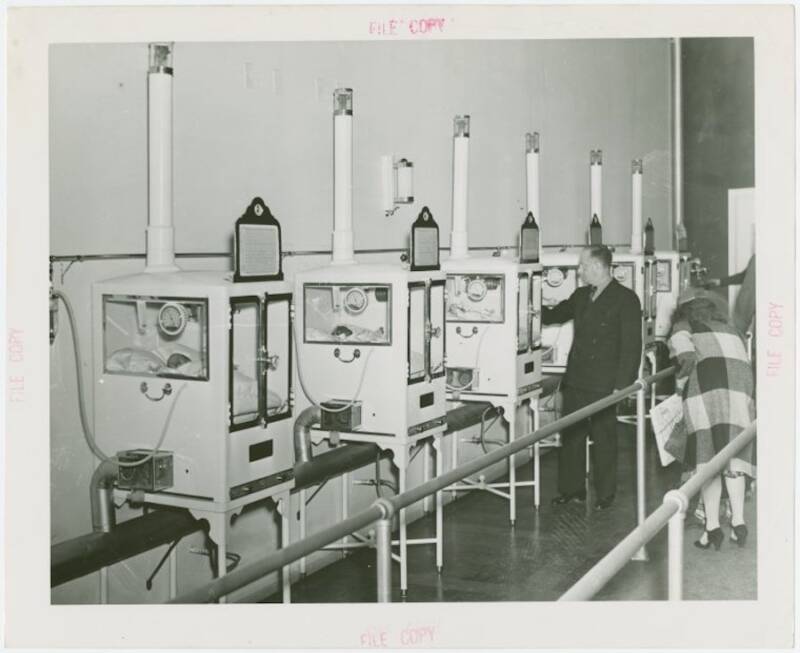The Carnival Show of Premature Babies: The Remarkable Journey of Martin Couney and the Incubator Babies
In the vibrant world of 1930s Coney Island, amid the echoes of sideshow excitement and the whirl of carnival rides, one man dared to defy convention and transform the lives of thousands of vulnerable infants. Known as the “Incubator Doctor,” Martin Couney, initially a controversial figure, would go on to be celebrated as a hero whose innovative approach changed the landscape of neonatal care.

Martin Couney’s incubator exhibition at the 1934 New York World’s Fair. Much of his journey to this point is a matter of speculation and myth.
Imagine strolling down the iconic Coney Island boardwalk in the 1930s, where 10 cents could immerse you in a world of sideshow wonders and thrilling rides. For an extra 25 cents, you could witness something truly extraordinary – Martin Couney and his groundbreaking incubator babies. Those who paid the fee were greeted by rows of glass incubators, showcasing tiny premature infants, some as small as 1 lb., courageously fighting for their lives.
In retrospect, Couney’s sideshow wasn’t just a spectacle; it was a lifesaving revolution that reshaped the care provided to premature babies worldwide. Born as Michael Cohn in 1869 in Krotoszyn, Poland, Couney’s early life remains a mystery. Like many sideshow entertainers, he was quick to adapt his past to fit a captivating narrative upon immigrating to America in 1888.
Claiming to hold a European medical license after studying medicine in Leipzig and Berlin, Couney’s tales faced skepticism from historians who unanimously believe he lacked formal medical training. Regardless, his journey intersected with Dr. Pierre-Constant Budin, a pioneer in neonatal medicine, according to Couney’s claims. While evidence of their relationship remains uncertain, Budin’s “child hatchery” became a sensational success, captivating crowds at various exhibitions.
By the early 1900s, Couney successfully utilized incubators to save premature babies, a mission fueled by personal experience. In 1903, he married nurse Annabelle Maye, and four years later, their daughter Hildegarde, born prematurely, weighed just three pounds. Couney’s involvement with incubators became not just a profession but a personal mission, as premature babies faced grim survival odds with little available medical care.
Undeterred by medical skepticism and the exorbitant costs associated with incubator exhibits, Couney, armed with exposition experience, set up sideshows at Coney Island’s Luna Park and Dreamland in 1903. Even a fire that razed Dreamland in 1911 couldn’t extinguish Couney’s determination, as the NYPD miraculously saved all incubator babies.
For 40 years, the Luna Park sideshow, funded by visitor proceeds, served as a haven for premature infants. By the time Couney closed the exhibition, he had saved over 6,500 lives, including that of his own daughter. Lucille Horn, born in 1920, was one such beneficiary. Her twin sister succumbed shortly after birth, but thanks to the Couney sideshow, Lucille thrived, living a fulfilling life until her passing in 2017 at the age of 96.
Despite initial reluctance from the medical community, the 1940s witnessed a shift as “child hatcheries” found acceptance in hospitals’ neonatal care routines. Couney finally closed his sideshow in 1943, yet his legacy endured. Techniques like “Kangaroo care” and advanced antiseptic measures, pioneered by Couney, became integral to modern medical practices.
Today, approximately one in 10 babies in the United States is born prematurely, with significantly improved survival rates, all thanks to Couney’s groundbreaking “child hatcheries.” Dr. Martin Couney passed away in 1950, leaving behind a legacy as the savior of thousands. His sideshows and Coney Island exhibitions paved the way for contemporary American medical advancements in caring for premature births.
As a radio spot for his incubators at the 1933 Chicago World’s Fair aptly stated, “The Incubator station for premature babies is not primarily a place of exhibiting tiny infants. Instead, it is actually a lifesaving station, where prematurely born babies are brought from leading hospitals all over the city, for the care and attention that are afforded.” The boardwalk became a stage for a genuine miracle, where the unconventional became a beacon of hope for the tiniest of lives.
